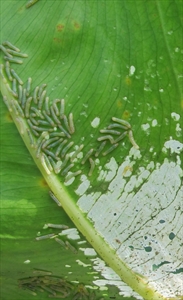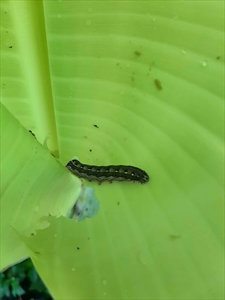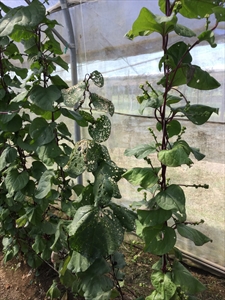Taro cluster caterpillar, taro armyworm, tobacco cutworm, tropical armyworm
Pacific Pests, Pathogens, Weeds & Pesticides - Online edition
Pacific Pests, Pathogens, Weeds & Pesticides
Taro cluster caterpillar (031)
Spodoptera litura. It is a member of the Noctuidae.
Asia, Oceania. It is recorded from Fiji, Samoa, Solomon Islands, and Tonga.
Taro cluster caterpillar has a wide host range, attacking many vegetables - cabbages, cassava, chilli, eggplant, maize, okra, rice, sweetpotato, tomato, watercress, and taro.
It is the caterpillar (or larva) that does the damage. The young caterpillars radiate from the egg masses (Photo 1), stripping the leaf surface and eating the leaf between the veins (Photos 2&3). Later, they become solitary and eat all the leaf, including the petioles. Mostly, they feed at night.
The cream to golden-brown egg masses (4-7 mm diameter) are covered with hairy scales from the tip of the abdomen of the female. After hatching, the caterpillars stay together (hence the name 'cluster caterpillar'). They vary in colour: pale green at first, then dark green to brown (Photo 4). There have bright yellow stripes along the top of the body. The caterpillars moult five times during 15-30 days, depending on the temperature. Afterwards, they pupate in the soil for 7-10 days.
If the eggs are laid on a plant that is inedible, the young caterpillars drop silken threads and are carried on the wind to other potential hosts. However, many types of plants are hosts (Photo 5&6).
The body of the moth is grey-brown, 15-20 mm long, with a wingspan of 30-40 mm (Photo 7). The forewings are grey to reddish brown with a strongly variegated pattern. The hindwings are greyish-white with grey margins. The moths can fly up to 1.5 km a night. They are attracted to light.
Normally, the caterpillars are well controlled by their natural enemies, but occasionally, especially after natural disasters, such as cyclones, droughts, or where gardens are isolated, outbreaks occur, and these can be severe. The caterpillars chew large areas of the leaf and, when numerous, can defoliate a crop. In such cases, the larvae migrate in large groups from one field to another in search of food (hence the alternative name "armyworm").
The caterpillars can also be a problem when crops are grown under protected cropping systems (Photos 8-10).
Look for the egg masses: they are relatively easy to see against the dark green of the leaves. Look for the 'scratch' marks left by the newly hatched larvae on the leaf surface. Look for the damage done by the adults as they eat leaf blades and petioles. Look for the older caterpillars at night.
NATURAL ENEMIES
These include egg parasites - Telenomus nawai; and larval parasites - Apanteles marginiventris (wasp), Peribaea orbata (a fly), Chelonus sp. (wasp), Palexorista sp. (a fly), and many more.
CULTURAL CONTROL
It is important that growers visit their gardens frequently and regularly, twice a week is recommended, to check if there are egg masses and young caterpillars on the leaves. Mostly, taro cluster caterpillar is under control by natural enemies, and it is only very occasionally that outbreaks occur.
- Remove leaves with egg masses or young caterpillars - this is an effective control measure. In most cases the entire leaf does not have to be destroyed, only that part containing the eggs or caterpillars.
- Alternatively, destroy the eggs and/or caterpillars by rubbing them with a hand or another leaf.
- If there are many large caterpillars, and damage looks likely, let chickens into the garden.
CHEMICAL CONTROL
Pesticides are not normally recommended for the control of this moth on taro. They are only needed when the natural enemies have been destroyed by cyclones, droughts, or when plantings are in isolated places. In these situations, do the following:
- Use plant-derived products (see FactSheet no. 56), such as neem, derris, pyrethrum and chilli (with the addition of soap), or commercial products that contain disease-causing organisms, such as spinosad (Success) and Bt - Bacillus thuringiensis var. kurstaki.
- Synthetic pyrethroids are likely to be effective, but will also kill natural enemies.
--------------------
Note, derris (Derris species) contains rotenone, an insecticide, often used as a fish poison; it should be used with caution. The commercial derris insecticide is made from Derris elliptica.
____________________
When using a pesticide (or biopesticide), always wear protective clothing and follow the instructions on the product label, such as dosage, timing of application, and pre-harvest interval. Recommendations will vary with the crop and system of cultivation. Expert advice on the most appropriate pesticide to use should always be sought from local agricultural authorities.
AUTHORS Helen Tsatsia & Grahame Jackson
Information from Carmichael A, et al. (2008) TaroPest: an illustrated guide to pests and diseases of taro in the South Pacific. ACIAR Monograph No. 132, 76 pp. (https://lrd.spc.int/about-lrd/lrd-project-partners/taropest); and (with Photo 5) from Carmichael A (2008) Cluster Caterpillar (Spodoptera litura). PaDIL - http://www.padil.gov.au. Photo 2 Kumar S, Secretariat of the Pacific Community. Photos 5,6,8-10 Mani Mua, SPC, Sigatoka Research Station, Fiji.
Produced with support from the Australian Centre for International Agricultural Research under project PC/2010/090: Strengthening integrated crop management research in the Pacific Islands in support of sustainable intensification of high-value crop production, implemented by the University of Queensland and the Secretariat of the Pacific Community.













